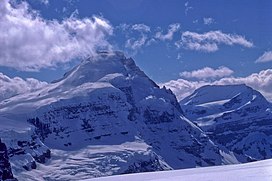Mount Columbia (Canada)
| Mount Columbia | |
|---|---|
 Mount Columbia &King Edwardin background | |
| Highest point | |
| Elevation | 3,747 m (12,293 ft)[1] |
| Prominence | 2,383 m (7,818 ft)[2] |
| Isolation | 157.6 km (97.9 mi)[3] |
| Listing | |
| Coordinates | 52°08′50″N117°26′30″W/ 52.14722°N 117.44167°W[4] |
| Geography | |
| Country | Canada |
| Provinces | AlbertaandBritish Columbia |
| Park | Jasper National Park |
| Parent range | Winston Churchill Range (Canadian Rockies) |
| Topo map | NTS83C3Columbia Icefield[4] |
| Climbing | |
| First ascent | 1902 byJames Outram,guided byChristian Kaufmann[1] First winter ascent 1944 by Douglas Groff |
| Easiest route | Glacier climb |
Mount Columbiais a mountain located in theWinston Churchill Rangeof theRocky Mountains.It is the highest point inAlberta,Canada,and issecond onlytoMount Robsonfor height andtopographical prominencein theCanadian Rockies.It is located on the border between Alberta andBritish Columbiaon the northern edge of theColumbia Icefield.Its highest point, however, lies withinJasper National Parkin Alberta.[5]
The mountain was named in 1898 byJ. Norman Collieafter theColumbia River.[1] The river itself was named after the American shipColumbia Redivivacaptained byRobert Gray,who first ventured over a dangerous sandbar and explored the lower reaches of the river in 1792.[6] Mount Columbia was first ascended in 1902 by James Outram, guided by Christian Kaufmann. The first winter ascent of Columbia was completed on March 14, 1944, by about thirty men led by Major Douglas Groff[7]of Winnipeg, during the course of a three-day patrol on the Icefield, using snow holes as sleeping quarters.
Climbing routes[edit]

The normal route is on the east face, a non-technicalglacierclimb that is straightforward in summer, albeit with a long approach (approx. 19 km (12 mi)) up the Athabasca Glacier and over theColumbia Icefield.Camping by King's Trench can reduce the approach down to 8 km (5.0 mi). Other routes include the North Ridge, which is more technical (Grade V, YDS 5.7, W3) but considered more spectacular.[1]
Geology[edit]
Mount Columbia is composed ofsedimentary rocklaid down from thePrecambriantoJurassicperiods. Formed in shallow seas, this sedimentary rock was pushed east and over the top of younger rock during theLaramide orogeny.[8]
Climate[edit]
Based on theKöppen climate classification,Mount Columbia is located in asubarctic climatewith cold, snowy winters, and mild summers.[9]Temperatures can drop below -20 °C with wind chill factors below -30 °C.
See also[edit]
- List of mountains of Alberta
- List of mountains of British Columbia
- List of mountains in the Canadian Rockies
- List of highest points of Canadian provinces and territories
- Mountain peaks of North America
- Mountain peaks of the Rocky Mountains
References[edit]
- ^abcd"Mount Columbia".cdnrockiesdatabases.ca.Retrieved2003-11-06.
- ^"Mount Columbia".Bivouac.com.Retrieved2007-01-17.
- ^"Mount Columbia, Alberta/British Columbia".Peakbagger.com.Retrieved2024-05-02.
- ^ab"Mount Columbia".BC Geographical Names.Retrieved2014-02-09.
- ^"Mount Columbia".Peakbagger.com.Retrieved2018-03-06.
- ^ "Cape Disappointment State Park (WA)".National Park Service.Retrieved2014-02-09.
- ^Gibson, Rex (1946)."Alpine Club of Canada Journal".American Alpine Club.Retrieved2023-04-06.
- ^Gadd, Ben (2008),Geology of the Rocky Mountains and Columbias
- ^Peel, M. C.; Finlayson, B. L. & McMahon, T. A. (2007). "Updated world map of the Köppen−Geiger climate classification".Hydrol. Earth Syst. Sci.11:1633–1644.ISSN1027-5606.
Gallery[edit]
-
Mount Columbia, from the summit ofSnow Dome
-
From Mt. Columbia summit looking SW
External links[edit]
- "Mount Columbia".BC Geographical Names.
- "Mount Columbia (Canada)".Peakware.com.Archived fromthe originalon 2016-03-04.





